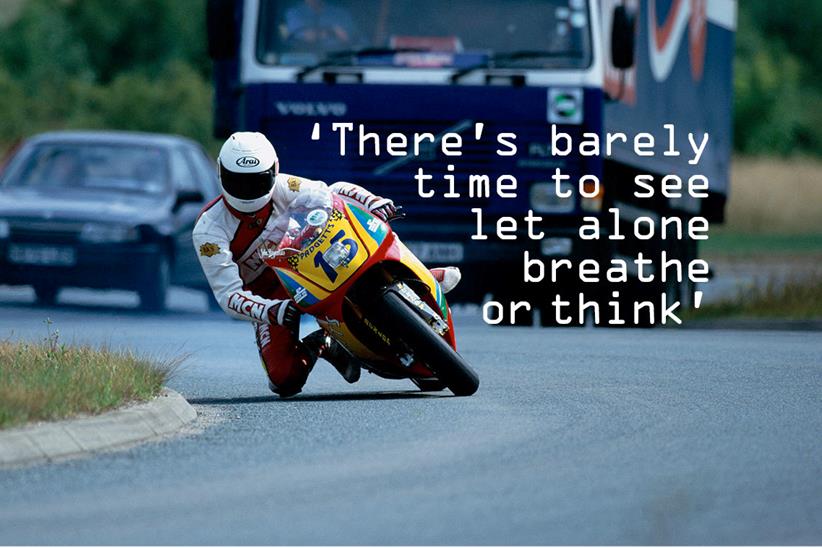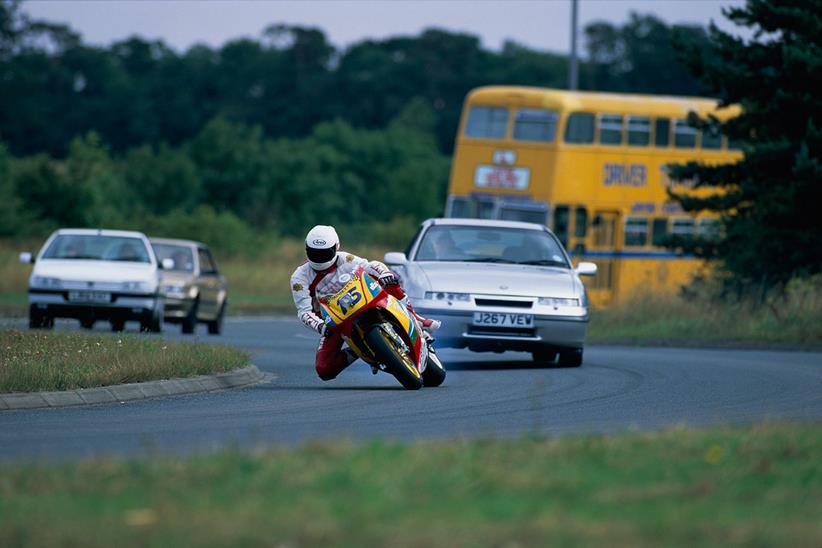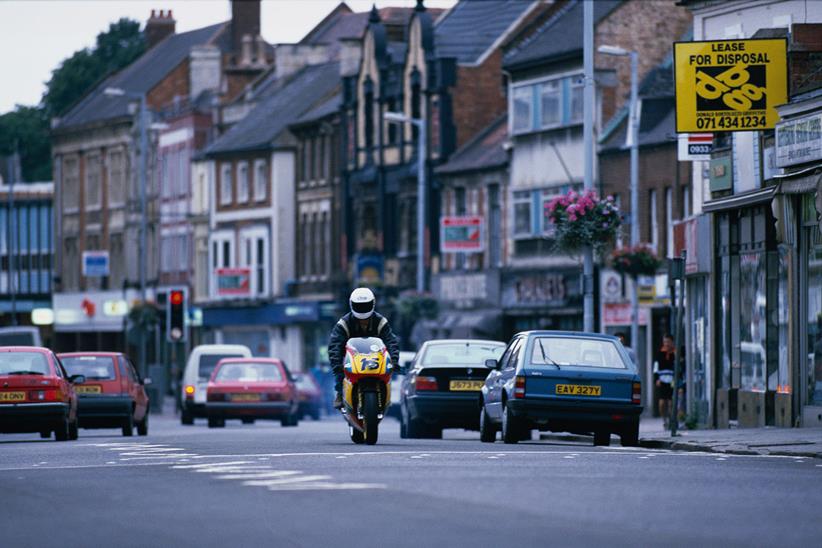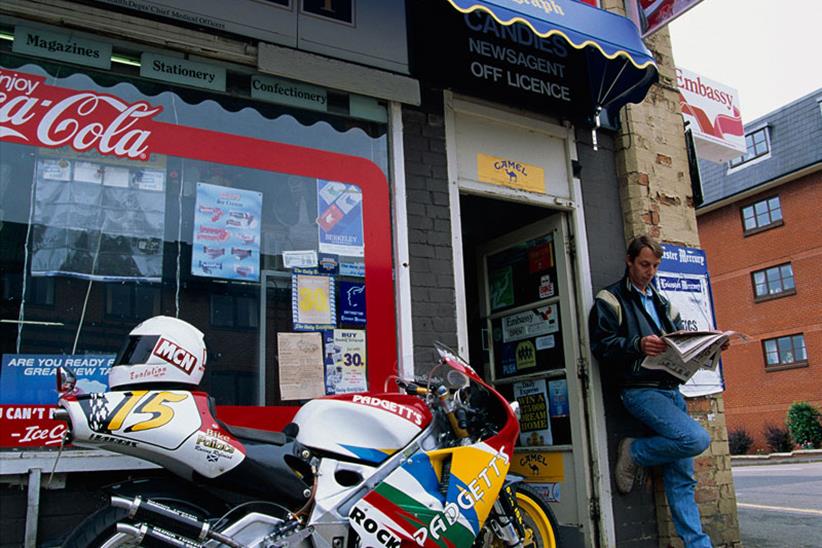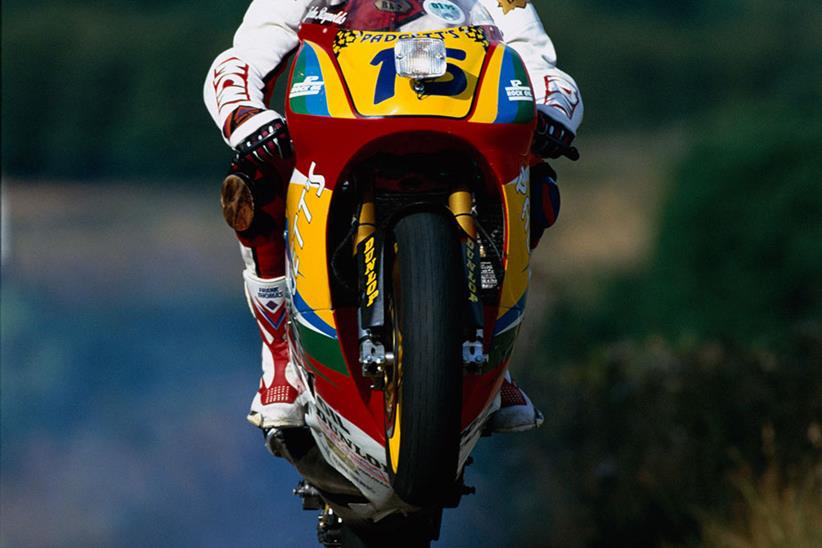Unforgettable ride: what happened when we rode a YZR 500 on the road
‘WHAT THE **** WAS THAT?’ was how we originally headlined this unforgettable story from August 1994, when Kevin Ash unleashed a pukka GP 500 on the roads – hiding behind the legal figleaf of headlamp and horn (of dubious functionality)…
![]() ake another look at pictures. Study the bike, what it seems to be, and where it is. Check the date. It’s not April 1. Now look at the pictures in the test on these pages. You can see cars, road signs, houses even, all the extraneous bits and bobs we usually go to great pains to leave out of our photographs. This time they’re included deliberately. That’s because what we’ve done is so outrageous, so unthinkable, so plain incredible you’ll need constant reminding that it has really happened.
ake another look at pictures. Study the bike, what it seems to be, and where it is. Check the date. It’s not April 1. Now look at the pictures in the test on these pages. You can see cars, road signs, houses even, all the extraneous bits and bobs we usually go to great pains to leave out of our photographs. This time they’re included deliberately. That’s because what we’ve done is so outrageous, so unthinkable, so plain incredible you’ll need constant reminding that it has really happened.
The bike has a tax disc, a number plate, lights, speedo and even a horn. Nothing unusual in that. Except it belongs to the Padgett racing team, and it is ridden at the weekends by a man called John Reynolds. The bike is a Harris Yamaha YZR500 grand prix racing machine, in action on the roads of Britain.
You could do this too. Yes you personally can ride one of these bikes. There are three ways of getting your leg across the most exotic, fabulous breed of motorcycle in existence. The first is to sell everything you and the rest of your family owns, and buy road-going version from Padgett’s. If you really want one, and really have the money, Padgett’s will oblige, though you’ll have to make do with a second hand bike. Don’t expect a two-year warranty, and it will definitely not have been treated gently by the previous owner.
The second way is to join Padgett’s ‘181 Club’. The details are explained elsewhere in this feature, but the bottom line is that included in the £1000 joining fee is a ride on a Harris Yamaha 500 on a major UK race track. Not cheap, but then neither is the bike. Finally, you could win a whole series of motorcycle races, at national then international level, and be asked to ride a 500 GP bike by someone who thinks you’ll do well on it. They’ll even pay you to do it. For this you need more talent in your little finger than the average biker totals in his lifetime. Despite this, and almost unbelievably, the YZR is not difficult to ride. It may demand god-like status to race, but out on the streets it is mild mannered and undemanding. Given some respect…
![]()
‘A furious banshee, livid at being woken’
Starting is rather basic – after all, everything on this bike is essential, there is nothing superfluous. Which means you fire up your £65,000 bike by bumping it down the road. The latest Mikuni carburettors have power jets in the place of the older versions’ crude choke system, so you connect the self-generating ignition wire, select first gear, pull in the clutch and start running. And running…
Keep the throttle closed and if the gods are smiling (which they must be, or you wouldn’t have got near a bike like this), the engine will start spluttering after 50 metres or so. It isn’t a motor that “bursts into life”. Ordinary engines do that. This is a furious banshee, livid at being woken, which screams angrily as you blip the throttle, the four pipes spitting bursts of blue smoke out the back to prove it is ready for action.
It eventually settles to a rhythmic rise and fall of the rev counter, and won’t even offend the neighbours if the needle stays below 4000rpm. Let the temperature gauge rise off its stop, and the bike is ready to ride away. You, meanwhile, will think of a hundred things that have to be done first. Numbers flick through your mind that don’t seem to match. The bike weights just 130kg dry, only slightly more than a 125cc Cagiva Mito. But the V4 two-stroke engine blasts out around 170bhp at the back wheel, on a par with a turbocharged ZZ-R1100.
![]()
Dare you let out the clutch?
Of course you do, that’s why you’re here. But very, very gently. It takes up the drive unevenly, braying and rattling like Ducatis are prone to (and not a lot worse). A lurch or two, and that’s it, you’re rolling. The bike is so well behaved at this stage it’s almost disappointing. Power is available from the depths of the rev counter, even as low as 2000rpm, and it will purr happily at 3000 revs for as long as you like. Tigers purr happily too.
Open the throttle some more, and the bike impresses again, not with uncontrollable power, but smooth, forceful acceleration. A little bit of this and you’ll become confident, almost. You won’t last though, by 6000rpm the road is looking narrower, the bike thrusting you foward with the strength of a FireBlade, the exhaust note rising in pitch and volume. And you’re still well below the power band.
At this stage, it’s best to knock the short-travel lever up for the next ratio, watching the revs drop by a thousand or so. If you don’t, and the throttle is anywhere near half open, the front wheel will rise as surely as the sun at dawn. Only much, much quicker… Even in fourth you have to be careful. The bike doesn’t care that it’s travelling at two and half miles a minute. It will still wheelie to punish a clumsy right hand.
Another dimension
Enter the power band, and you’re into another dimension. The acceleration is out of this world. The bike doesn’t so much throw you forward as pluck you from the space you were in and hurl you into another an unthinkable distance ahead. There’s barely time to see, let alone breathe or think, yet you still have to get forward over the tank to try to keep some vestige of weight on the front wheel.
This happens beyond 9000rpm, and keeps on happening up to 13,000rpm. In the lowest two gears you have to treat the throttle with exaggerated delicacy, like handling an endangered species of butterfly. A tiny touch too hard and the YZR will punish you with a smack in the face from the clocks. Any heavier and it will bury you in the tarmac.
In third or fourth it is still violently fast. By sixth, it’s merely devastating, but you’re moving past 160mph. (You are, of course, on a private test track.) The sheer cascade of endless horsepower is quite astounding, but that only makes the engine’s behaviour at low revs all the more impressive. The bike will trickle around town, through traffic, waiting at the lights, nip down to your head back and look up to see where you’re going.
It isn’t perfect. Rough surfaces and potholes were not a consideration in setting up the suspension, and the YZR is upset by them, bouncing upright where the local council has been neglecting the track… sorry, road. But on smoother surfaces the ride quality is excellent, not the harsh, eye watering jarring through the bars you might expect. It glides along in places, maximising the rubber’s contact with the road and remaining utterly composed.
Staying on the seat
Flick the bike down and it responds with the speed of a 125, but straight line stability isn’t as solid as some road bikes, such as a VFR750. It doesn’t weave, but the front shuffles a little, as if it’s waiting to be turned into a corner. Again, it hardly matters in the bike’s true arena.
It won’t come as a surprise that the riding position is perfect for when you do want to throw the bike through some bends. It is actually less radical than a ZXR750, and the bike is more comfortable over a distance despite the vestigial padding on the seat – its width compensates for that. The bars are low, of course, and do stress the wrists around town (did I really say that of a YZR500?) but the footpegs are further from the seat than several race replicas and don’t strain your knees so much. An added luxury is under-seat heating, as two of the four fat, sculpted expansion chambers are routed just an inch below your bum, exiting the tail unit above the number plate.
Staying on the seat isn’t easy when you apply the brakes. The pair of fully floating discs and four-position Brembo callipers stop the bike as effectively as running into a lake of wet cement, tipping so much weight on to your wrists you have to make a conscious effort not to get flung over the bars. The rear is quite useful too. On the track it is used to limit power to hear rear wheel to control slides coming out of corners. So I’m told…
The stoppers do make the bike stand up to some extent, or conversely make it harder to tip down into corners, something which doesn’t happen with the sharper profiled front slick I wasn’t allowed to fit for the road. Now that several road bikes use 190 section rear rubber, road legal tyres aren’t a problem for the YZR. In fact, we fitted Dunlop D364s, with a 180 section on the back which is suitable for the six-inch rim, but there is a fair choice. Don’t expect tyre manufacturers to recommend a fitting though.
Verdict
Well, we did it. And the real surprise wasn’t the shoulder-wrenching acceleration, the exotic handling or the bone-snapping brakes. That was only to be expected. Instead, we were amazed at how easily the bike coped with constant, low speed riding and even trickling through traffic. It didn’t overheat, foul spark plugs, burn the clutch out or spit the rider off at the first hint of throttle. If only Yamaha or any of the other 500GP contenders could bring themselves to mass produce a road going version. It wouldn’t be as powerful, but that would be an advantage. Its sales would be limited to countries that could accept the two-stroke exhaust emissions, but it would sell out twice over in those. It was done half-heartedly before, with the 500LC and RG500. Come on, forget the nanny governments of the world. Get back to what motorcycles are all about. Fun above absolutely anything else.
|
SPECIFICATION |
|
|
Price |
£2,449 |
|
Insurance group rating |
|
|
NU (of 17) |
n/a |
|
Devitt (of 22) |
n/a |
|
Engine |
|
|
Layout |
¼ twin crank two-stroke |
|
Capacity |
499cc |
|
Bore/stroke |
56mm x 50.6mm |
|
Porting |
7 transfer, 3 exhaust |
|
Exhaust valve |
Electronically controlled cylindrical |
|
Fuel system |
4 x 35mm Mikuni power jet flat slide carburettors |
|
Cooling |
Liquid |
|
Compression |
n/a |
|
Power |
170bhp @ 12,500rpm approx. |
|
Torque |
70ftlb @ 11,500rpm approx |
|
Transmission |
|
|
Gearbox |
6-speed |
|
Final drive |
Chain |
|
Cycle parts |
|
|
Frame |
Twin spar aluminium |
|
FRONT SUSPENSION |
45mm Ohlins inverted telescopic forks |
|
Adjustments |
Pre-load, rebound and compression damping |
|
REAR SUSPENSION |
Rising rate 0hlins monoshock |
|
Adjustments |
Pre-load, rebound and compression damping |
|
Tyres |
|
|
Make |
Dunlop D364 |
|
Front |
120/70 x 17 |
|
Rear |
180/55 x 17 |
|
Brakes |
|
|
Make |
Brembo |
|
Front |
2 x 320mm fully floating discs, 4-piston Brembo callipers |
|
Rear |
Single 260mm disc, 2-piston Nissin calliper |
|
Dimensions |
|
|
Wheelbase |
Adjustable |
|
Dry weight |
130kg (287lb) |
|
Seat height |
80cm (31.5in) |
|
Rake/trail |
Adjustable |
|
Fuel tank |
24 litres (5.3 gallons) |
|
Manufacturer/importer |
|
|
Supplier |
Padgett’s 0924-478491 |
|
Warranty |
none |
|
PERFORMANCE |
|
|
Top speed |
181mph |
|
Standing ¼-mile |
11s @ 135mph |
|
0-60mph |
3.1 secs |
|
Fuel consumption (MPG) |
|
|
Average |
22 |
|
Best |
25 |
|
Ridden hard |
15 |
|
Range |
120 miles |
|
RATING |
|
|
Performance |
****** |
|
Handling |
****** |
|
Braking |
****** |
|
Equipment |
* |
|
Value |
****** |
